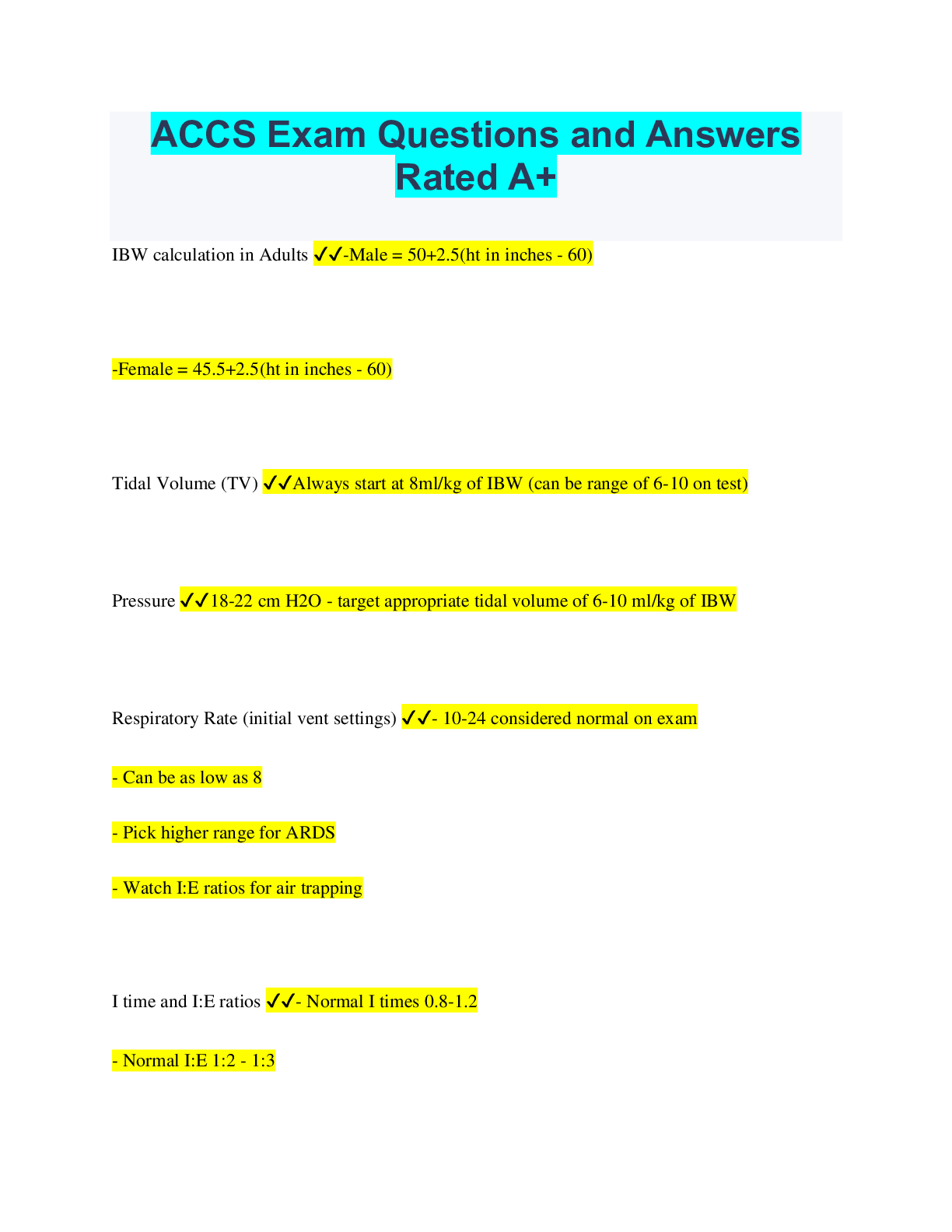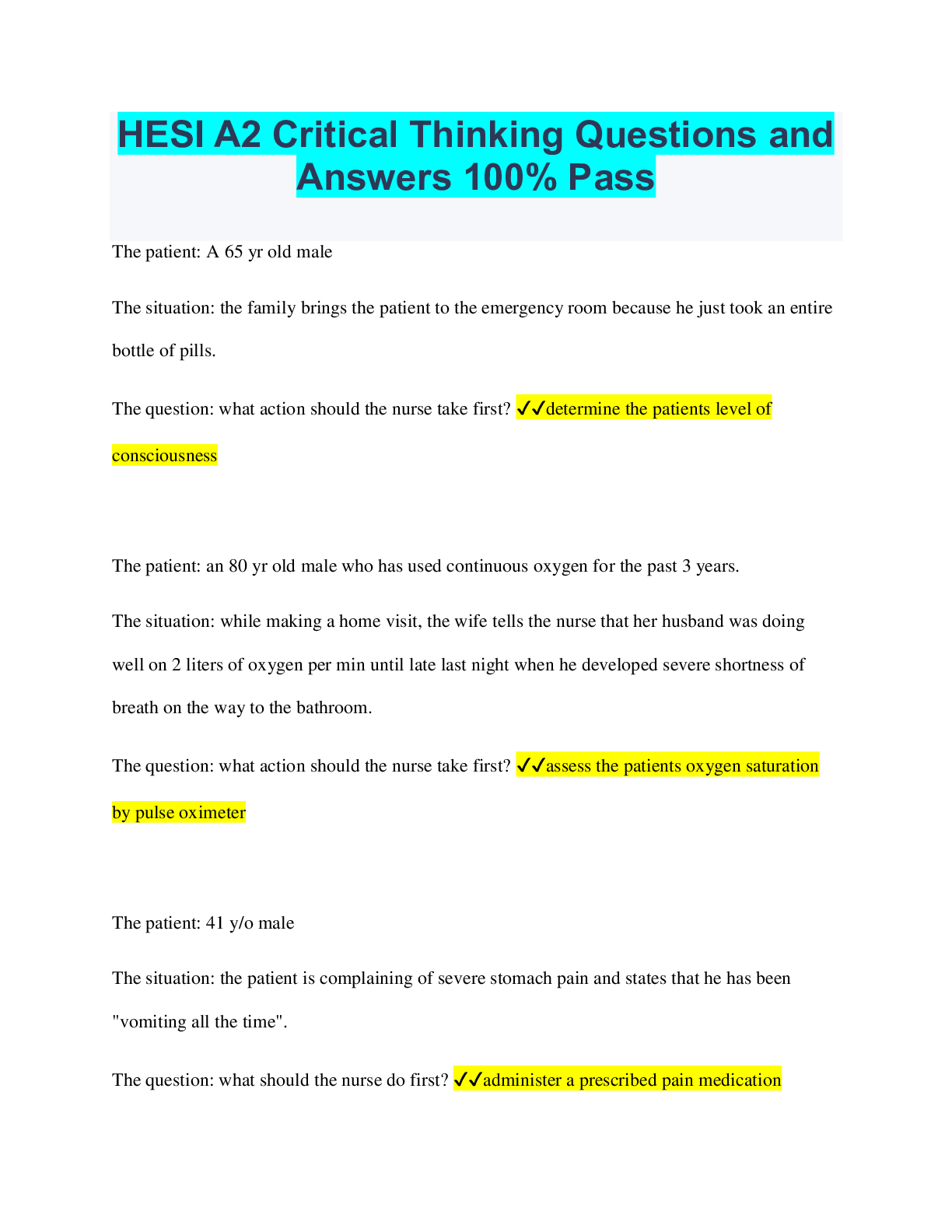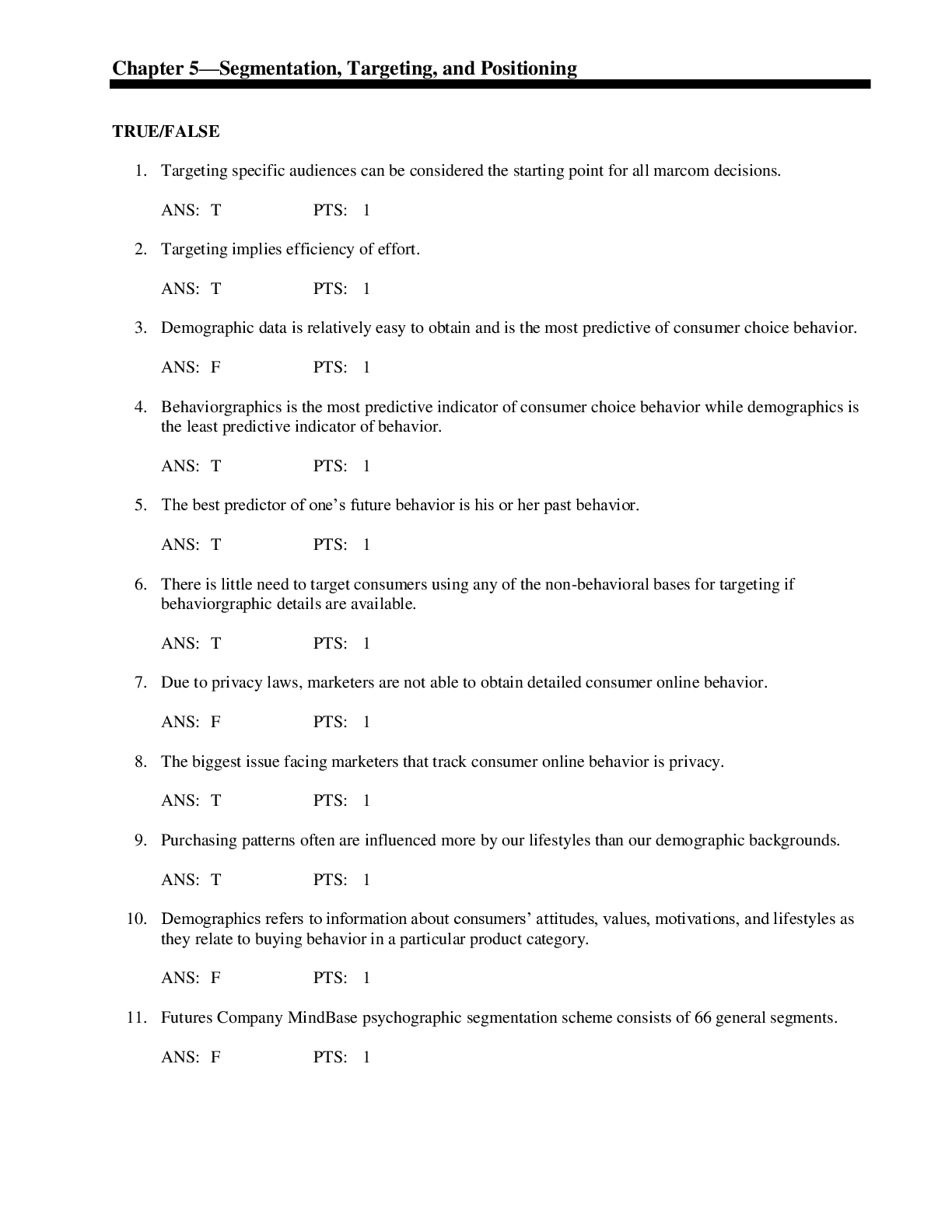Social Sciences > QUESTIONS & ANSWERS > ACCS Exam Questions and Answers Rated A+ (All)
ACCS Exam Questions and Answers Rated A+
Document Content and Description Below
ACCS Exam Questions and Answers Rated A+ IBW calculation in Adults ✔✔-Male = 50+2.5(ht in inches - 60) -Female = 45.5+2.5(ht in inches - 60) Tidal Volume (TV) ✔✔Always start at 8ml/kg of I... BW (can be range of 6-10 on test) Pressure ✔✔18-22 cm H2O - target appropriate tidal volume of 6-10 ml/kg of IBW Respiratory Rate (initial vent settings) ✔✔- 10-24 considered normal on exam - Can be as low as 8 - Pick higher range for ARDS - Watch I:E ratios for air trapping I time and I:E ratios ✔✔- Normal I times 0.8-1.2 - Normal I:E 1:2 - 1:3 - Larger I:E times for COPD,Asthma,CF 1:4-1:5 PEEP ✔✔- For exam anything over 6 is therapeutic and a reason needs to exist before applying it - Uses of higher PEEP - refractory hypoxia ( V/Q mismatch ) - If given P/F ratio less than 200 good clue to increase PEEP *Use fio2 instead of PEEP in hypotensive or hemodynamicly unstable patients* Ventilation Issues - ACCS ✔✔For ACCS purposes, treating a pH up to as low 7.30 is reasonable (particularly for ARDS where fixing a pH/PaCO2 may result in a lung injury) Watch WOB - indicates asynchrony on vent or needs to be placed on one if not on vent Improving ventilation - conventional way ✔✔- Increase RR while ensuring adequate I:E - Cautiously consider increasing tidal volume but never beyond 8 ml/kg IBW - Ensure patient is not air trapping Improving ventilation - "advanced" ✔✔- Increase perfusion to health lung - bad lung up, good lung down (BLU GLD) - Improve perfusion in patient's on high O2 by administering iNO or prostaglandins Identifying an oxygenation issue ✔✔- For ACCS, treat to an adequate PaO2 (about 60 for ACCS) - Increasing FiO2 doesn't typically help on exam consider instead refractory oxygenation (V/Q mismatch - atelectasis, consolidation), or when perfusion isn't adequate. - more effective to optimize ventilation/perfusion by putting areas of good ventilation with good perfusion or by improving it (recruiting lung etc...) "Advanced" Oxygenation Techniques ✔✔- recruitment maneuver (placed pt on CPAP of 30-40 for 30-40 seconds and then place back on previous setting or slightly higher PEEP) - Placed patient in prone position (changes the dependent areas of the lungs) - APRV, a recruitment mode when traditional ventilation is failing, for ACCS purposes - HFOV another recruitment mode for ACCS purposes APRV ✔✔- essentially a constant recruitment maneuver - APRV allows for spontaneous breaths at any time - APRV allows the alveoli to deflate some but never collapse preventing damage - Phigh and Thigh determine mean airway pressure - Wean by "drop and stretch" (drop Phigh in 2-3 mcH2O increments and increase Thigh in 0.5-1 sec increments) - Initial settings Phigh 15-30; Plow 0-10; Thigh 3-6, Tlow 0.4-0.6, pressure support 0-6, FiO2 - current or higher - for acidosis increase pHigh by 2-3 and if PaO2 is good decrease Thigh by 0.5-1 - for hypoxemia increase Phigh by 2-3 and increase Thigh by 0.5-1, also recruitment maneuver HFOV ✔✔- MAP and Insp % are main determinants of oxygenation - Amplitude and frequency are main determinants of ventilation (increase amplitude or decrease frequency for respiratory acidosis - if both options available chose amplitude) - Initial settings: Map - match conventional MAP or up a few; %ins time - 33%; Hertz - 4-8 hz for exam (1 hertz is 60 cycles of insp and expir); Amplitutude - 90 cm H2O Albumin ✔✔- Normal 3.5-5.5 - decreased in chronic liver disease, hypovolemia, burns, ascites, malnutrition - increased with dehydration, severe diarrhea - administer Albumin for hypovolemia, severe burns - for hyperalbuminemia treat dehydration by giving fluid RBC's ✔✔RBC's 4-6 million per mcl Hb 13-18 g/dl Hematocrit 36-55% Transfusion Trigger: when Hb is less than 8g/dl then recheck in as early as 15 min BUN and creatinine ✔✔BUN: 6-20 mg/dL Creatinine: 0.6-1.3mg/dL High BUN and creatine suggests impaired kidney function Liver Assessment ✔✔Bilirubin 0-1 mg/dl; hyprbilirubinemia indicates sepsis, shock, acute and chronic pancreatitis, hepatitis, sarcoidosis, tb [Show More]
Last updated: 2 years ago
Preview 1 out of 5 pages

Buy this document to get the full access instantly
Instant Download Access after purchase
Buy NowInstant download
We Accept:

Reviews( 0 )
$9.00
Can't find what you want? Try our AI powered Search
Document information
Connected school, study & course
About the document
Uploaded On
Jun 17, 2023
Number of pages
5
Written in
Additional information
This document has been written for:
Uploaded
Jun 17, 2023
Downloads
0
Views
88


























